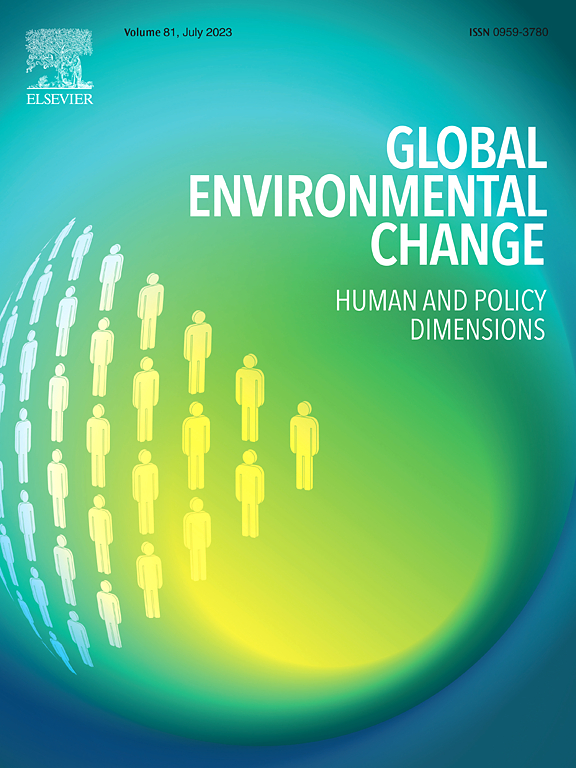Land-use spillovers from environmental policy interventions
IF 9.1
1区 环境科学与生态学
Q1 ENVIRONMENTAL SCIENCES
引用次数: 0
Abstract
Environmental policy interventions are crucial for addressing biodiversity loss and climate change, yet their effectiveness can be compromised by land-use spillovers, where efforts to reduce impacts in one place displace them elsewhere. Despite growing recognition of spillovers, they remain unevenly defined, inconsistently measured, and poorly integrated into policy evaluation and accountability frameworks. This systematic review synthesizes current research on land-use spillovers triggered by environmental policies, including carbon pricing, protected areas, supply chain interventions, and payments for ecosystem services. We identify three dominant pathways: leakage, indirect land use change (iLUC), and positive spillovers, emerging under common conditions such as weak enforcement, market integration, limited livelihood alternatives, and accessible frontier lands. These conditions are shaped by broader institutional, economic, demographic, and biophysical drivers, yet are rarely integrated into policy design and evaluation. While methods to evaluate spillover effects range from global scale ex ante models to local ex post spatial and econometric analyses, few studies bridge scales or connect findings to international policy frameworks such as the Convention on Biological Diversity (CBD) or the United Nations Framework Convention on Climate Change (UNFCCC). Cases are concentrated in climate-linked interventions and in South America, leaving important geographic and sectoral blind spots. This limits their relevance for designing policies that minimize displaced impacts and foster more durable outcomes. Advancing spillover research will require common frameworks, more consistent methodologies, and multi-scale tools that can enhance comparability, attribution, and integration into environmental governance.
环境政策干预带来的土地使用溢出效应
环境政策干预对于解决生物多样性丧失和气候变化问题至关重要,但其有效性可能受到土地利用溢出效应的影响,即在一个地方减少影响的努力会在其他地方被取代。尽管越来越多的人认识到溢出效应,但它们的定义仍然不均匀,衡量方法也不一致,而且很难纳入政策评估和问责框架。本系统综述综合了目前关于由环境政策引发的土地利用溢出效应的研究,包括碳定价、保护区、供应链干预和生态系统服务支付。我们确定了三种主要途径:泄漏、间接土地利用变化(iLUC)和积极溢出效应,它们出现在执法不力、市场一体化、有限的生计选择和可获得的边境土地等常见条件下。这些条件受到更广泛的制度、经济、人口和生物物理驱动因素的影响,但很少被纳入政策设计和评估。虽然评估溢出效应的方法多种多样,从全球尺度的事前模型到局部事后空间和计量经济学分析,但很少有研究将尺度联系起来,或将研究结果与《生物多样性公约》(CBD)或《联合国气候变化框架公约》(UNFCCC)等国际政策框架联系起来。病例集中在与气候有关的干预措施和南美洲,留下了重要的地理和部门盲点。这就限制了它们在制定政策以尽量减少流离失所影响和促进更持久成果方面的相关性。推进溢出效应研究需要共同的框架、更一致的方法和多尺度工具,以增强可比较性、归因性和融入环境治理。
本文章由计算机程序翻译,如有差异,请以英文原文为准。
求助全文
约1分钟内获得全文
求助全文
来源期刊

Global Environmental Change
环境科学-环境科学
CiteScore
18.20
自引率
2.20%
发文量
146
审稿时长
12 months
期刊介绍:
Global Environmental Change is a prestigious international journal that publishes articles of high quality, both theoretically and empirically rigorous. The journal aims to contribute to the understanding of global environmental change from the perspectives of human and policy dimensions. Specifically, it considers global environmental change as the result of processes occurring at the local level, but with wide-ranging impacts on various spatial, temporal, and socio-political scales.
In terms of content, the journal seeks articles with a strong social science component. This includes research that examines the societal drivers and consequences of environmental change, as well as social and policy processes that aim to address these challenges. While the journal covers a broad range of topics, including biodiversity and ecosystem services, climate, coasts, food systems, land use and land cover, oceans, urban areas, and water resources, it also welcomes contributions that investigate the drivers, consequences, and management of other areas affected by environmental change.
Overall, Global Environmental Change encourages research that deepens our understanding of the complex interactions between human activities and the environment, with the goal of informing policy and decision-making.
 求助内容:
求助内容: 应助结果提醒方式:
应助结果提醒方式:


